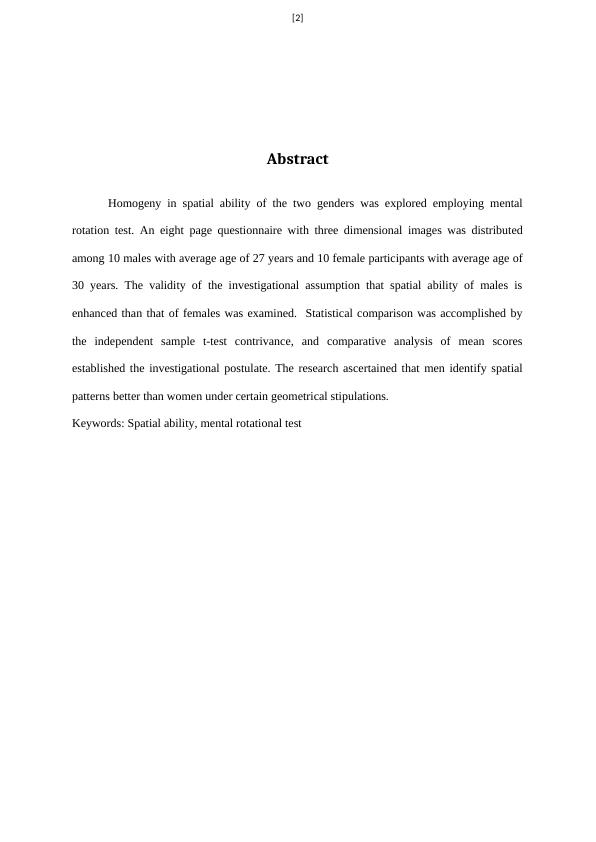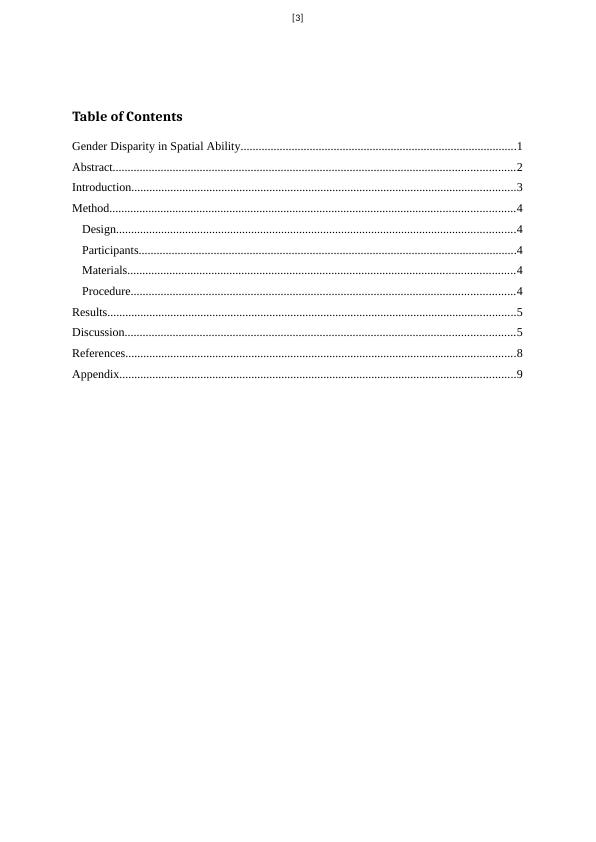Gender Disparity in Spatial Ability: Mental Rotation Test
Added on 2023-06-08
15 Pages1617 Words273 Views
[1]
Gender Disparity in Spatial Ability
Gender Disparity in Spatial Ability

[2]
Abstract
Homogeny in spatial ability of the two genders was explored employing mental
rotation test. An eight page questionnaire with three dimensional images was distributed
among 10 males with average age of 27 years and 10 female participants with average age of
30 years. The validity of the investigational assumption that spatial ability of males is
enhanced than that of females was examined. Statistical comparison was accomplished by
the independent sample t-test contrivance, and comparative analysis of mean scores
established the investigational postulate. The research ascertained that men identify spatial
patterns better than women under certain geometrical stipulations.
Keywords: Spatial ability, mental rotational test
Abstract
Homogeny in spatial ability of the two genders was explored employing mental
rotation test. An eight page questionnaire with three dimensional images was distributed
among 10 males with average age of 27 years and 10 female participants with average age of
30 years. The validity of the investigational assumption that spatial ability of males is
enhanced than that of females was examined. Statistical comparison was accomplished by
the independent sample t-test contrivance, and comparative analysis of mean scores
established the investigational postulate. The research ascertained that men identify spatial
patterns better than women under certain geometrical stipulations.
Keywords: Spatial ability, mental rotational test

[3]
Table of Contents
Gender Disparity in Spatial Ability............................................................................................1
Abstract......................................................................................................................................2
Introduction................................................................................................................................3
Method.......................................................................................................................................4
Design.....................................................................................................................................4
Participants..............................................................................................................................4
Materials.................................................................................................................................4
Procedure................................................................................................................................4
Results........................................................................................................................................5
Discussion..................................................................................................................................5
References..................................................................................................................................8
Appendix....................................................................................................................................9
Table of Contents
Gender Disparity in Spatial Ability............................................................................................1
Abstract......................................................................................................................................2
Introduction................................................................................................................................3
Method.......................................................................................................................................4
Design.....................................................................................................................................4
Participants..............................................................................................................................4
Materials.................................................................................................................................4
Procedure................................................................................................................................4
Results........................................................................................................................................5
Discussion..................................................................................................................................5
References..................................................................................................................................8
Appendix....................................................................................................................................9

[4]
Introduction
Spatial capacity to recognize two dimensional objects in three dimensional
geometrical shapes is a genetic attribute of humans. Solid angle rotation with rigid body
translation transforms a known shape to a complex contour with an altered geometrical depth.
The reaction time to identify the complex object appropriately signifies the level of
intellectual ability. A frequently used instrument to assess spatial ability using three
dimensional geometrical figures was suggested by Shepard and Metzler's (1971) mental
rotation errand. Participants were comparatively slower in identifying two similar three
dimensional objects distinguished by large solid angles. Hegarty (2018) tested the validity of
the mental rotation test with feature-based analytic strategies and argued against the
significance of previous spatial ability tests. Doyle and Voyer (2018) improvised the
experimental structure with pictures of revolving human figures and equivalent block
diagrams to find reduced gender disparity in spatial recognition in identifying human figures
compared to analogous diagrams. Boone, Alexander, Hegarty, and Mary (2017) established
similar results of gender parity in their research paper with test of Vandenberg & Kuse
(1978).
The scholar conducted this exploration with an attempt to associate with the results of
previous literatures. The current work testified the gender disparity in spatial ability, with the
experimental postulation that predicted higher mental rotational test scores of men compared
to women. The null hypothesis presumed significantly identical test scores for both the
genders.
Introduction
Spatial capacity to recognize two dimensional objects in three dimensional
geometrical shapes is a genetic attribute of humans. Solid angle rotation with rigid body
translation transforms a known shape to a complex contour with an altered geometrical depth.
The reaction time to identify the complex object appropriately signifies the level of
intellectual ability. A frequently used instrument to assess spatial ability using three
dimensional geometrical figures was suggested by Shepard and Metzler's (1971) mental
rotation errand. Participants were comparatively slower in identifying two similar three
dimensional objects distinguished by large solid angles. Hegarty (2018) tested the validity of
the mental rotation test with feature-based analytic strategies and argued against the
significance of previous spatial ability tests. Doyle and Voyer (2018) improvised the
experimental structure with pictures of revolving human figures and equivalent block
diagrams to find reduced gender disparity in spatial recognition in identifying human figures
compared to analogous diagrams. Boone, Alexander, Hegarty, and Mary (2017) established
similar results of gender parity in their research paper with test of Vandenberg & Kuse
(1978).
The scholar conducted this exploration with an attempt to associate with the results of
previous literatures. The current work testified the gender disparity in spatial ability, with the
experimental postulation that predicted higher mental rotational test scores of men compared
to women. The null hypothesis presumed significantly identical test scores for both the
genders.

End of preview
Want to access all the pages? Upload your documents or become a member.
Related Documents
Sex Differences in Nanoblock Assembly Performancelg...
|19
|3246
|292
(pdf) meta-analysis of the relationship between digit-ratiolg...
|13
|3068
|98
Analysis of Dataset: Descriptive Statistics and T-testslg...
|29
|4228
|56
A Comparison of Self-Estimated IQ Scoreslg...
|14
|3141
|76
